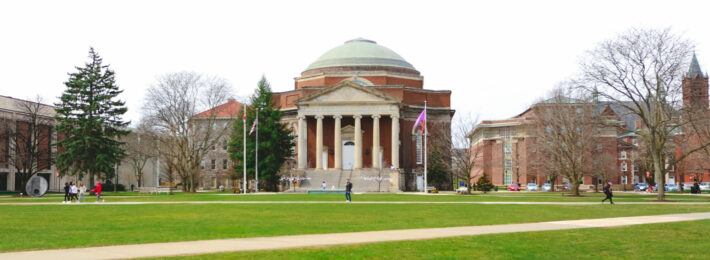
During the last decade, a few high-profile donor stories throughout the country have heightened public awareness of university namings. In response, “reputational risk” or “morality” clauses started popping up more frequently in university gift agreements. These clauses generally stipulate that an institution can remove a naming should the institution’s association with the name prove problematic in the future. The hope was that these clauses would allow institutions to disassociate themselves with the names of those who might become mired in scandal or criminal activity at some point in the future. But times are changing, and our institutions have been forced to consider how those changes impact the expectations of our internal and external community.
Higher education institutions were forced to alter just about everything in response to the Covid pandemic. Seemingly overnight, classes moved to virtual formats, faculty and staff switched to remote work, buildings locked down, and in-person activities ceased. At the same time, our nation’s calls for justice and equality left many wondering if it was time for some of the names at our universities to go. Although our campuses sat empty, the names associated with our institutions became much more significant. The pandemic required swift work and necessitated immediate response. But our response to our country’s growing social justice movement necessitates a more deliberate approach.
I have spoken with both institutional and professional colleagues throughout the country in the last several months and one thing is clear, universities throughout the nation are trying to figure out how to proceed in addressing existing namings.
You might think that a university founded in 1972 wouldn’t have much to worry about in terms of historical namings, but in recent years my university has grappled with the history of its namesake. George Mason IV was a slaveholder. He also authored the Virginia Declaration of Rights, the precursor to the United States Bill of Rights. Think about that for a moment. How can one human being have done both? While there are those who would encourage that his name be removed from our university, there are others who would equally argue that it should stay. There is no easy answer, and certainly not all naming examples are quite so extreme.
A multi-year research project at our university led to a better understanding of George Mason’s involvement in slavery. Faculty and students collaborated to explore the history of our namesake’s home and to learn more about those who labored there. Later this year, we will unveil a campus memorial to honor, educate and provide a voice to those he enslaved. Last summer came official word that we will keep our university name, but we will also ensure that future generations understand the complexities of our namesake.
As the university community gave thought to our name, a few things stood out that can help inform decisions elsewhere:
- Our namesake may be an extreme example, but human beings are inherently complex creatures. They are more than just one thought, one belief and one moment in their life span. And this is exactly where decisions can get tricky.
- Universities have a responsibility to educate current and future generations. While the name of our university may be a matter now settled, that doesn’t mean we won’t continue with the larger task of reviewing other namings at our institution through the work of a newly established university Anti-Racism and Inclusive Excellence Task Force.
We have only just begun to embark upon our naming review work, but already the lessons we learned through the experience of researching our namesake are providing us with some good guidance. As my colleagues and I approach this work, we are considering a variety of factors.
- How can we best involve students in this process? Students are the most valuable asset at every institution and involving them in the work of research and review can offer them a tremendous educational opportunity and a better understanding of the names on our campuses.
- What is our end goal? Do we want to remove namings, or do we want to use namings to help educate the masses? This is a difficult question and one that needs to be approached thoughtfully. Removing a name is equally as complex of a process as bestowing it. In the end, there may not be a one size fits all approach.
- Do we want to focus strictly on matters of anti-racism and inclusion, or might there be other reasons for us to give thought to specific names? Should other issues be considered? For example, incidents of sexual harassment or misconduct or other activities that might not align with institutional values?
As we make decisions and recommendations in the coming months, we know that many of our higher education colleagues at other institutions will be approaching the same work at their universities. As I have spoken with colleagues from other universities, I find myself returning to the same three topics of conversation.
1. What, if anything, do our university policies say about naming reviews and removals?
At many institutions, this may be the first time a naming review is necessary. It is one thing to put a clause in a gift agreement, it is another to have a policy that backs up that clause.
First, determine whether your university has a current policy. If you have never had to remove a name, you may not. If you are fortunate enough to have an existing policy, when was the last time it was updated? Does it specify who needs to be involved in decisions, or how recommendations should be moved forward to leadership for consideration? These will be key factors in how you proceed.
If your current policy stipulates who should be involved in any review and recommendations, think carefully about whether it incorporates the perspectives of a diverse, multi-generational group of constituents. If it doesn’t, consider making a change. No one person should be charged with making recommendations. Many voices make for better decisions. In addition, make sure all involved in the process understand who has advisory abilities, and who has decision-making authority—some will be part of the process, while others will be responsible for the ultimate decision. And while a large group can help bring many perspectives and views to the table, it can also sometimes lead to over-analysis. At the end of the day, leadership or a governing body needs to be responsible for making decisions, communicating the rationale for the decisions, and moving the institution forward.
2. Institutions associate themselves with names in many ways
When we speak of namings, it is easy to focus on large and highly visible items at our institutions. Buildings, academic schools, centers, and the very names of universities themselves. But before an institution declares that it will review namings, it needs to decide what exactly that means. There are the standard philanthropic and honorary namings, but what about the other names that appear on our campuses. Will a review scratch the surface, or dig deeper? Does your university confer honorary degrees? Does it have an Alumni Hall of Fame? An Athletics Hall of Fame? Does it honor and display the jerseys of former student athletes?
Again, there are no easy answers. Depending upon the age of your university, it may be near impossible to review every name of association, but a clear path and an articulated plan at the start of your process will help your constituents better understand the decisions made at the end.
3. Communication will be the most important part of the process.
No matter what direction you choose– removal or education, or what criteria you use, communication will be the most important factor in your review process. Be honest and clear about what you can and cannot review, how you will make decisions, and how outcomes will be conveyed. In addition to your master communication plan, you should also have a plan for how you will communicate with donors or descendants who may be impacted by decisions. If your institution is in contact with the donors or families of those once honored, communicate decisions to them first. Having your family name in the press or removed from a place of recognition is never easy and if we put their name on something, we owe them the courtesy of letting them know we will be altering or removing it.
In the end, each institution needs to handle naming reviews in their own way. A few years ago, we watched as multiple institutions struggled with decisions related to the Sackler Family name. Some institutions removed the name, others kept it. All had reasons for their decisions. Cultural shifts take time and even if the physical removal of a name can happen quickly, getting the name out of your institutional culture may take generations. Alumni and community members often default to using the name they have used for decades, not out of offense, but simply out of habit. As we review the current namings at our universities, it is difficult to fathom how current norms and names may be viewed in 50, 100, or 150 years. One thing is certain though, how we respond to current naming concerns will play a role in the legacy we leave for our institutions and constituents in the future.


